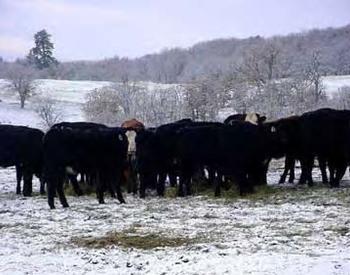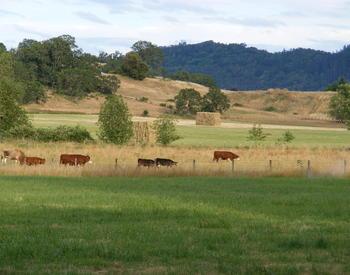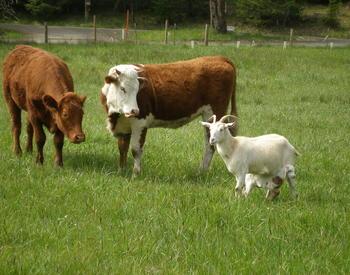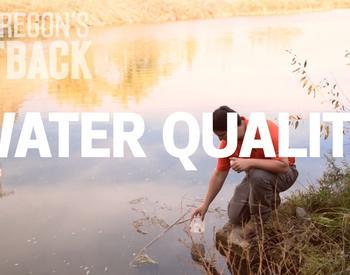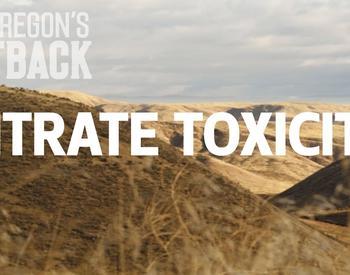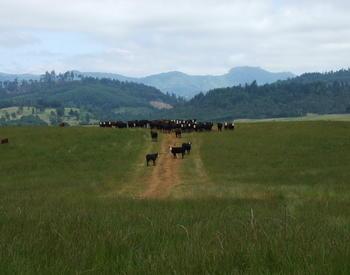Introduction
The vast majority of U.S. grass seed production occurs in the states of Oregon, Washington and Idaho. These states produce approximately 95% of all Kentucky bluegrass seed grown in the United States. In addition, Oregon produces approximately 96% of all ryegrass and orchardgrass seed and 87% of all fescue seed harvested in the United States. A byproduct of grass seed production is straw (residue remaining after grass seed has been harvested). While grass seed straw is generally a low-quality forage source, the ruminant animal and its microbial population can utilize it with proper nutritional management.
Nutritional quality of grass straw for ruminants
Grass seed straws and other low-quality forages
In general, grass seed straw is comparable in nutritional quality on a crude protein (CP) basis to most meadow hays and superior to most cereal grain straws (Table 1). However, there are usually CP differences between species of grass seed straw, as provided in Table 2. On average, bluegrass is the highest CP followed by perennial ryegrass, tall fescue, bentgrass, orchardgrass, other fescues (not including tall fescue) and annual ryegrass.
As with CP, total digestible nutrients (TDN) can vary with species of grass seed straw. Table 1 lists two values for TDN.
The first, TDNa, is based on a formula routinely used to estimate TDN for all classes of forages based on the acid detergent fiber (ADF) concentration. This equation, 88.9 – (0.79*ADF%), was developed primarily for legumes and grasses and often gives TDN values that overpredict performance compared with that actually observed by cattle consuming low-quality forages like grass seed straw.
The second equation, 71.7 – (0.49*ADF%), was developed specifically for low-quality straws. This equation provides TDN values that are roughly 7% to 8% less than those calculated using TDNa and, consequently, more accurately predicts performance of cattle consuming low-quality forages.
Therefore, we suggest using TDNb, rather than TDNa, to evaluate cattle diets based on grass seed straw and other comparable low-quality forages. This will require calculating the TDN value using the referenced equation and the ADF value from your nutritional analysis of the forage.
Comparison to animal requirements
The nutritional requirements of various classes and stages of production of cattle are listed in Table 3. Crude protein and TDN requirements are highest for growing animals and lactating cows. When used as the major component of the diet, grass seed straw does not have the digestible CP and/or TDN to support optimal performance in these classes of livestock.
Simply stated, beef cattle in high nutrient requirement production stages cannot consume enough grass seed straw to meet nutrient demands (Table 1; NRC, 1984). Consequently, grass seed straw should primarily be offered to mature cows and bulls as a maintenance ration. Also, grass seed straw will normally require some form of supplementation, usually CP and energy, to be used efficiently by mature bulls and non-lactating, mature cows.
Alkaloid concerns
Some species of grass seed straw contain alkaloids produced by endophyte fungus, which can cause animal health and/or neurological concerns if the alkaloids are consumed in high concentrations. Consequently, concern over alkaloid concentration in grass seed straw has hampered its use as a forage source for ruminants. Tall fescue and perennial ryegrass are the two most common species of grass seed straw that can contain high levels of alkaloids. The alkaloid most often associated with tall fescue straw is ergovaline while perennial ryegrass straw can have ergovaline and lolitrem B.
Alkaloids in tall fescue have caused fescue foot (Figure 1), summer syndrome or fescue toxicosis (depressed intake, elevated body temperature and respiration rate), fat necrosis, agalactia (decreased milk production), reproductive problems and death in ruminants consuming tall fescue.
Perennial ryegrass can contain ergovaline (an alkaloid present in tall fescue) in addition to lolitrem B. Therefore, perennial ryegrass can cause health disorders normally associated with tall fescue, as well as a neurological disorder associated with consumption of lolitrem B called “perennial ryegrass staggers.” This disorder normally manifests itself in ruminants after consuming lolitrem B infected perennial ryegrass for 7 to 14 days. Clinical symptoms include incoordination, staggering, tremors, head shaking and collapse. Animals demonstrating clinical symptoms should be removed from the causative feed source, whereby symptoms normally subside in 2 to 14 days.
Management recommendations concerning alkaloids
Grass seed straws, primarily tall fescue and perennial ryegrass, are often purchased and fed to livestock without knowledge of the concentration of ergovaline or lolitrem B present in them. This increases the potential for incidences of fescue toxicity and/or perennial ryegrass staggers. Consequently, the first step in feeding potentially alkaloid infected grass seed straw is to have it tested for alkaloids. It should be noted that perennial ryegrass straw should be tested for lolitrem B and ergovaline. If you would like assistance deciding on what alkaloid test(s) are appropriate, and/or would like to send samples in for analysis, you can call Oregon State University’s Endophyte Testing Laboratory at 541-737-2872.
Once the concentration of alkaloids in a grass seed straw is known, proper nutritional management can be carried out. The estimated threshold levels of ergovaline and lolitrem B in the diet of cattle is 400 to 750 ppb and 1,800 to 2,000 ppb, respectively. These values can be used to minimize the chance of causing clinical symptoms of fescue toxicosis and perennial ryegrass staggers when feeding alkaloid-infected grass seed straw. The threshold levels for ergovaline may vary because environmental factors and stress also play a role in the development of clinical disease. Specifically, the threshold levels for ergovaline decrease in hot or cold weather. This is especially important to remember when feeding grass seed straw during periods of severe weather (freezing temperatures and snow).
Grass seed straws that contain alkaloid (ergovaline and/or lolitrem B) concentrations above the recommended threshold levels can be effectively used as forage resources. However, this will require increased nutritional management and diligent observation of livestock consuming the straw.
The most common and effective means of feeding alkaloid-infected grass seed straw is to blend it with non- or low-alkaloid-infected forage. The “rule of thumb” is to use a 50:50 mix of infected and non- or low-alkaloid-infected forage (bluegrass straw, meadow hay, alfalfa, etc.). A modified type of mixing or blending practice is to provide the high-alkaloid straw on a separate day from the low-alkaloid or alkaloid-free forage. The simplest example would be to provide high-alkaloid straw every other day with hay or low-alkaloid straw provided on the alternate days. This serves the same purpose as diluting the high-alkaloid straw by 50%. In addition to reducing the overall alkaloid intake, feeding straw on alternate days has the following additional benefits compared with a “hay mix” every day:
- Less work, and potential human error, feeding one forage source per day compared with two.
- More consistent intake of both forage sources due to minimization of sorting and the “boss” effect caused by dominant animals in the herd or flock.
- Better control over alkaloid intake, especially if alkaloid concentration and intake thresholds are known. For instance, it may be possible to provide the high-alkaloid straw two out of three days and still maintain alkaloid intake below threshold levels.
There has been some success with feed additives that minimize the effects of grass seed straw with high concentrations of ergovaline. The primary supplements proposed to ameliorate the effects of high concentrations of ergovaline (resulting in fescue toxicosis) include Integral (Alltech Animal Nutrition; Nicholasville, KY), Endo-Fighter (ADM Alliance Nutrition; Quincy, IL), and Tasco® (Acadian Seaplants Ltd.). However, these ingredients are not a “silver bullet” that will solve the issues of feeding a high-alkaloid grass seed straw. They are just another “tool” in our toolbox that can be used, along with blending, to minimize the negative consequences of feeding high-alkaloid grass seed straw.
Conclusions
Given the availability of grass seed straw, and its ability to lower the cost of a ration, grass seed straw has the potential to be an economical management tool for most feeding programs that involve mature bulls and non-lactating cows. However, it is recommended that when purchasing grass seed straw, a producer obtain a nutrient analysis and determine if the straw contains toxic levels of alkaloids. Listed below are a series of questions and recommendations that a ruminant livestock producer should use before feeding grass seed straw.
- Determine nutritive value (CP, NDF, acid detergent fiber) using a certified lab – calculate TDN using the following equation: 71.7 – (0.49*ADF%).
- How does the price of grass seed straw compare with other forage sources? Evaluate cost per ton of dry matter and determine if supplementation is necessary.
- What is the species of grass seed straw (tall fescue, perennial ryegrass, bluegrass, etc.) and does it have the potential to contain toxic levels of alkaloids? If so, have it tested to determine the concentration of ergovaline and/or lolitrem B.
If the grass seed straw is considered acceptable, develop a nutritional management plan for its safe and effective use considering alkaloid threshold levels and/or forage quality (contact your county agent, extension specialist or nutritionist for assistance).
References
- Aldrich-Markham, and Pirelli. 1995. EM 8598. Oregon State University Extension Service, Corvallis.
- Bohnert et al. 2011. Pacific Northwest Animal Nutrition Conference Proc. pages 1-18.
- Cooke and Bohnert. 2011. BEEF059. Oregon State University Beef Cattle Sciences.
- Cheeke. 1995. J. Anim. Sci. 73:909-918.
- Davis et al. 2002. Prof. Anim. Sci. 18:127-134.
- Hemken et al. 1984. J. Anim. Sci. 58:1011-1016.
- Hemken, and Bush. 1989. In: P. R. Cheeke (Ed.) Toxicants of Plant Origin. Vol. 1: Alkaloids.
- Holland, and Kezar. 1995. Pioneer Forage Manual – A Nutritional Guide. pages 1-55.
- NRC. 1984. Nutrient Requirements of Beef Cattle.
- Stamm. 1992. M. S. Thesis. Oregon State University, Corvallis.
- Stuedemann, and Hoveland. 1988. J. Prod. Agric. 1:39-44.
This document is part of the Oregon State University – Beef Cattle Library. Prior to acceptance, this document was anonymously reviewed by two experts in the area.
| Nutritional Quality, Percentage Dry Matter Basis | ||||||
|---|---|---|---|---|---|---|
| Reference by Forage Type | Description | CP 1 | NDF 2 | ADF 3 | TDNa 4 | TDNb 5 |
| A. Low-Quality Meadow Hay | ||||||
| Experiment 1 | Meadow Fescue | 6.6 | 65.4 | 39.0 | 58.1 | 52.6 |
| Experiment 2 | Warm- and Cool Season Grasses | 5.2 | 70.8 | 46.1 | 52.5 | 49.1 |
| 7.0 | 74.4 | 45.6 | 52.9 | 49.4 | ||
| Experiment 3 | Warm- and Cool-Season Grasses | 4.3 | 72.9 | 46.2 | 52.4 | 49.1 |
| Experiment 4 | Native Meadow (Brome, Fescue, and Crested Wheatgrass) | 8.2 | 66.3 | 42.1 | 55.6 | 51.1 |
| Experiment 5 | Warm- and Cool-Season Grasses | 8.5 | 68.1 | 34.3 | 61.8 | 54.9 |
| Experiment 6 | Cool-Season grasses | 5.2 | 60.1 | 32.0 | 63.6 | 56.0 |
| 5.0 | 57.7 | 32.1 | 63.5 | 56.0 | ||
| B. Grass Seed Straws | ||||||
| Experiment 1 | Annual Ryegrass | 3.4 | --- | 44.9 | 53.4 | 49.7 |
| Experiment 2 | Fescue | 5.1 | --- | 53.0 | 47.0 | 45.7 |
| Experiment 3 | Perennial Ryegrass | 5.5 | --- | 50.6 | 48.9 | 46.9 |
| Experiment 4 | Bluegrass | 8.9 | --- | 43.7 | 54.4 | 50.3 |
| Experiment 5 | Bentgrass | 4.6 | --- | 45.6 | 52.9 | 49.4 |
| Experiment 6 | Annual Ryegrass | 4.8 | --- | 49.7 | 49.6 | 47.3 |
| Experiment 7 | Perennial Ryegrass | 6.9 | 71.7 | 42.5 | 55.3 | 50.9 |
| Experiment 8 | Perennial Ryegrass | 4.6 | 63.0 | 33.0 | 62.8 | 55.5 |
| 5.5 | 64.0 | 34.0 | 62.0 | 55.0 | ||
| Experiment 9 | Perennial Ryegrass | 4.2 | 68.8 | 44.0 | 54.1 | 50.1 |
| Experiment 10 | Bluegrass | 5.5 | --- | --- | --- | --- |
| Experiment 11 | Red fescue | 3.7 | --- | --- | --- | --- |
| Experiment 12 | Perennial Ryegrass | 8.9 | --- | 43.2 | 54.8 | 50.5 |
| Experiment 13 | Bluegrass | 5.9 | --- | --- | --- | --- |
| Experiment 14 | Hard Fescue | 4.3 | 73.8 | 32.0 | 63.6 | 56.0 |
| Experiment 15 | Bluegrass | 7.7 | 73.2 | 43.6 | 54.5 | 50.3 |
| Experiment 16 | Perennial Ryegrass – Turf type | 6.7 | 68.1 | 42.4 | 55.4 | 50.9 |
| Experiment 17 | Tall Fescue | 5.7 | 69.3 | 42.5 | 55.3 | 50.9 |
| Experiment 18 | Bentgrass | 5.2 | 67.7 | 41.1 | 56.4 | 51.6 |
| Experiment 19 | Perennial Ryegrass – Forage type | 4.9 | 72.1 | 45.5 | 53.0 | 49.4 |
| Experiment 20 | Orchardgrass | 4.8 | 79.0 | 49.6 | 49.7 | 47.4 |
| Experiment 21 | Annual Ryegrass | 3.7 | 75.6 | 50.5 | 49.0 | 47.0 |
| Experiment 22 | Chewings and Red fescue | 3.1 | 81.1 | 51.5 | 48.2 | 46.5 |
| Experiment 23 | Hard Fescue | 3.8 | --- | --- | --- | --- |
| Experiment 24 | Bluegrass | 6.3 | 66.4 | 36.2 | 60.3 | 54.0 |
| Experiment 25 | Tall Fescue | 6.3 | 67.4 | 44.6 | 53.7 | 49.8 |
| 5.3 | 71.1 | 49.2 | 50.0 | 47.6 | ||
| Experiment 26 | Tall Fescue - High Alkaloid | 5.6 | 72 | 43 | 54.9 | 50.6 |
| Experiment 27 | Tall Fescue - Low Alkaloid | 6.5 | 71 | 43 | 54.9 | 50.6 |
| C. Cereal Grain Straws | ||||||
| Experiment 1 | Wheat | 3.8 | --- | 49.0 | 50.2 | 47.7 |
| 2.6 | --- | 53.1 | 47.0 | 45.7 | ||
| Experiment 2 | Wheat | 2.9 | --- | 50.1 | 49.3 | 47.2 |
| Experiment 3 | Wheat | 2.3 | --- | --- | --- | --- |
| Experiment 4 | Barley | 3.8 | --- | --- | --- | --- |
| Experiment 5 | Oat | 2.2 | --- | --- | --- | --- |
| Experiment 6 | Barley | 3.9 | --- | --- | --- | --- |
| Experiment 7 | Wheat | 2.5 | --- | --- | --- | --- |
| Experiment 8 | Oat | 2.6 | --- | --- | --- | --- |
| Wheat | 3.6 | --- | --- | --- | --- | |
| Oat | 3.8 | --- | --- | --- | --- | |
| Barley | 4.9 | --- | --- | --- | --- | |
| Wheat | 3.4 | 82.6 | 56.7 | 44.1 | 43.9 | |
| Wheat | 2.5 | 78.5 | 55.1 | 45.4 | 44.7 | |
| Grass Seed Straw Species | Average CP (%) | Ranking |
|---|---|---|
| Bluegrass | 6.9 | 1 |
| Perennial ryegrass | 6.0 | 2 |
| Tall fescue | 5.9 | 3 |
| Bentgrass | 4.9 | 4 |
| Orchardgrass | 4.8 | 5 |
| Other fescues (not including tall fescue) | 4.0 | 6 |
| Annual ryegrass | 4.0 | 7 |
| Production Stage | Intake, lb | CP, % | CP, lb | TDN, % | TDN, lb |
|---|---|---|---|---|---|
| 700 lb Steer, Gaining 1.0 lb/day | 15.8 | 8.6 | 1.4 | 58.5 | 9.2 |
| 700 lb Heifer, Gaining 1.0 lb/day | 15.1 | 8.4 | 1.3 | 62.0 | 9.4 |
| 1200 lb Mature Cow | |||||
| MidGestation | 20.8 | 6.9 | 1.4 | 48.8 | 10.1 |
| LateGestation | 22.3 | 7.8 | 1.7 | 52.9 | 11.8 |
| Early Lactation | 23.0 | 9.3 | 2.1 | 55.5 | 12.8 |
| 2000 lb Mature Bull | |||||
| Maintenance | 31.3 | 6.8 | 2.1 | 48.4 | 15.2 |
- 1CP = crude protein
- 2NDF = neutral detergent fiber
- 3ADF = acid detergent fiber
- 4TDNa = total digestible nutrients calculated as described by Holland and Kazar (1995; 88.9 – (0.79*ADF%))
- 5TDNb = total digestible nutrients calculated as described by Davis et al. (2002; 71.7 - (0.49*ADF%))
- 6From data presented in Table 1.
- 7lb = pounds; CP = crude protein; TDN = total digestible nutrients.







